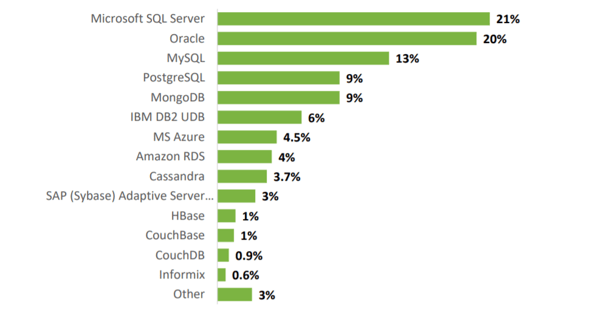Wow. Microsoft SQL Server (shortened to Microsoft SQL, MS SQL, or MSSQL) is almost 30 years old. It was released in 1989 for the IBM OS/2, which was a joint development effort, and was Microsoft’s first product for the enterprise-level database market. Fourteen versions later (some of which were given names like Pietro, Palato Mania, and Hekaton) and people are still using Microsoft SQL all over the world.
Using Microsoft SQL: The Case Against & The Case For
Microsoft SQL remains one of the most popular databases to date. Depending on your sources, it can occupy any of the top 3 positions for database systems. (We ourselves found Microsoft SQL Server to be the most popular system when we recently conducted an industry survey.)

This begs the question, why is MS SQL still so popular? Especially in recent years, with the rise of free, open-source databases such as MySQL, MongoDB, MariaDB, and PostgreSQL. Using Microsoft SQL imparts serious expenses, particularly at the enterprise level.
To get some insight and to understand why Microsoft SQL will still be around for a while, let’s look at six major reasons for its longevity.
1. It’s an Industry Standard
In a bit of a chicken/egg type situation, the widespread popularity and use of MS SQL databases has created a demand and supply for Microsoft SQL professionals. In other words, the fact that MS SQL servers are so common means that a lot of database administrators and developers have experience with them, therefore companies have an enormous base of talent from which to choose when hiring.
In addition, .NET professionals are often familiar with related programming languages like C# and VB.Net, so using Microsoft SQL can reduce staff training expenditure and personnel changes.
2. Compatibility with Other Microsoft Products
Microsoft still dominates the operating system market and many of the programs often used along with it. Because compatibility is optimized when a DBMS and OS are made by the same company, it’s just easier to stick with Microsoft products all around.
Similarly, during ETL (extract, transform, load), the interoperability of MS SQL’s server reporting, integration, and analysis services greatly facilitates the process.
It’s a similar picture with database languages. In case a database needs to be switched, reconnecting the new database’s program to the data access layer is made much easier when doing everything with .NET and SQL Server. Although many languages can handle this situation, using Microsoft languages is more straightforward.
Of course, we would be remiss if we didn’t mention the fact that many users are wary of exactly this situation. The prospect of a single vendor “owning” your technology stack is understandably disconcerting and many are unnerved by what looks like creeping vendor lock-in. Once locked in, your operation is liable to become dependent on and beholden to that vendor. Still, the conveniences and efficiencies cannot be denied and, as a result, a huge chunk of the market still opts for MS SQL.
3. Impressive Security Track Record
According to Microsoft, MS SQL has had the fewest security vulnerabilities over the past 7 years (when comparing to other databases). Microsoft SQL Server has recorded only 19 security vulnerabilities in 2010-2016, while other major databases have recorded 200 or more in that time period. The impressive track record is a direct result of measures taken by the company on code development security back in 2002, including a complete audit of all existing code, to ensure it is as bulletproof as possible.
4. Keeping Up with the Times
At long last, and after many years of pressure, the 2017 SQL Server release includes compatibility with Linux. This is part of a strategic change at Microsoft to yield to the demands of enterprises, particularly those running mixed environments.
In another move towards compatibility with open source, support of Docker containers (both Windows and Linux based) is also included in the 2017 version. Similarly, Python is now supported as well, as a follow up to the addition of the open source statistical language R, which was part of the 2016 release.
In September 2017, Microsoft announced the addition of in-database machine learning in SQL Server, with support for both R and Python. The Machine Learning Services feature supports AI and machine learning packages from the open-source in-database world.
Also included for those using the latest version of Microsoft SQL is a graph database within the core engine that boosts the utility of SQL servers for the Internet of Things (IoT), social network recommendations, and predictive analytics applications.
5. Enterprise-Grade Management Software
Microsoft SQL Server includes professional, enterprise-level database management software. Although other DBMSes, particularly from open source, have similar capabilities, MS SQL Server is known to have a relatively large number of features (for example, full support for triggers).
Ease of use is also an advantage. For instance, using Microsoft SQL you can host locally or remotely through a well-documented process. Moreover, SQL servers can be clustered to reduce single points of failure, increase efficiency of hardware resources, and facilitate maintenance and patching.
6. Data Recovery Support
Microsoft SQL Server uses its Data Protection Manager (DPM) for data restoration and recovery. Enterprises can use DPM as part of the Microsoft System Center, an integrated client-to-cloud management tool for private and public servers that offers continuous data protection.
One of DPM’s big advantages is that it comes with many options for backup and recovery through log files and caching. Backups can be disk-based or tape-based, while recovery can be applied to servers such as SQL Server, Exchange Server, SharePoint, virtual servers, and file servers, with support for Windows desktops and laptops. DPM can also centrally manage full, incremental, differential, and bare-metal backups.
MS SQL: Continuous Improvement for Database Durability
Microsoft’s evident enthusiasm for its SQL product line means that it will be around for a long time yet. Keep your eye on MS SQL for continuing innovations, both from Microsoft and from firms that design compatible products.
Find out more about database security.






